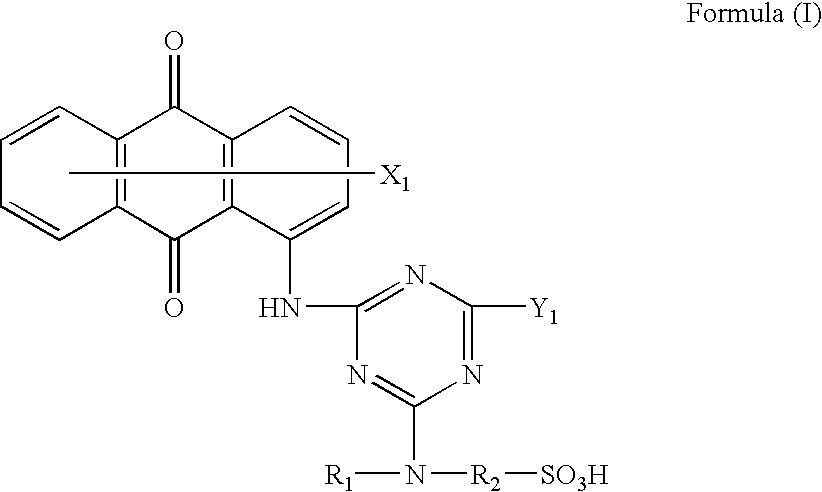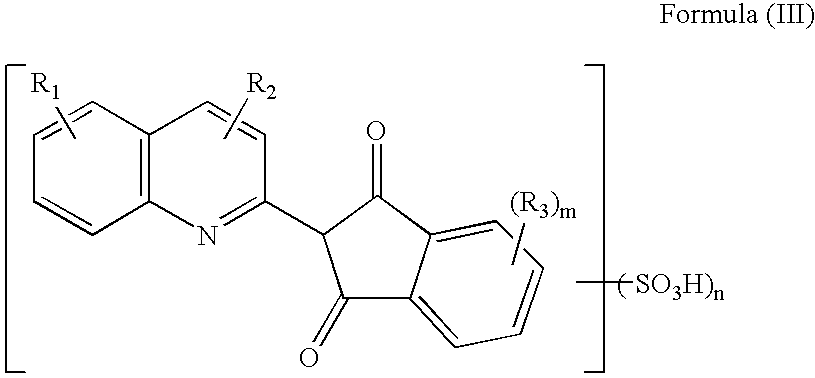Pigment dispersants and their use
- Summary
- Abstract
- Description
- Claims
- Application Information
AI Technical Summary
Benefits of technology
Problems solved by technology
Method used
Image
Examples
examples
[0052] Based on Synthesis Examples, Examples and Comparative Examples, the present invention will next be described more specifically. It is to be noted that all designations of “part”, “parts” and “%” are on a weight basis.
synthesis example a1
[0053] A diketopyrrolopyrrole pigment (C.I. Pigment Red 254, 30 parts) was added to 20% fumic sulfuric acid (300 parts), followed by a reaction at 60 to 65° C. for 6 hours. Subsequent to cooling, the precipitation of a composite according to the present invention was caused from the resultant mixture in iced water (3,000 parts). The formed precipitate was collected by filtration and then washed with water to obtain a water-based paste (110 parts, true amount: 28 parts). The water-based paste was dried to obtain a diketopyrrolopyrrole (a pigment dispersant A1, 28 parts), which was determined to contain on average 0.8 sulfonic group introduced per molecule from the results of an elemental analysis for sulfur.
[0054] Further, the pigment dispersant A1 (5 parts) and C.I. Pigment Red 254 (5 parts) were added to 95% sulfuric acid (100 parts), followed by stirring at room temperature for 1 hour. Subsequent to cooling, the resulting concentrated-sulfuric acid solution was poured into iced w...
synthesis example a2
[0055] The pigment dispersant A1 of Synthesis Example A1 (3.75 parts) and C.I. Pigment Red 254 (6.25 parts) were added to 95% sulfuric acid (100 parts), followed by stirring at room temperature for 1 hour. Subsequent to cooling, the resulting concentrated sulfuric acid solution was poured into iced water (1,000 parts); its pouring led the precipitation of a composite according to the present invention. The formed precipitate was collected by filtration and then washed with water to obtain a water-based paste (39 parts, true amount: 10 parts). The water-based paste was dried to obtain a diketopyrrolopyrrole (a pigment dispersant A3, 10 parts), which was determined to contain on average 0.3 sulfonic group introduced per molecule from the results of an elemental analysis for sulfur.
PUM
| Property | Measurement | Unit |
|---|---|---|
| Fraction | aaaaa | aaaaa |
| Fraction | aaaaa | aaaaa |
| Fraction | aaaaa | aaaaa |
Abstract
Description
Claims
Application Information
 Login to View More
Login to View More - R&D
- Intellectual Property
- Life Sciences
- Materials
- Tech Scout
- Unparalleled Data Quality
- Higher Quality Content
- 60% Fewer Hallucinations
Browse by: Latest US Patents, China's latest patents, Technical Efficacy Thesaurus, Application Domain, Technology Topic, Popular Technical Reports.
© 2025 PatSnap. All rights reserved.Legal|Privacy policy|Modern Slavery Act Transparency Statement|Sitemap|About US| Contact US: help@patsnap.com



